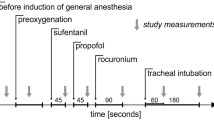Summary
The commonly used anaesthetics have a direct effect on myocardial performance and both arterial and venous peripheral vasculature, with secondary effects on the circulatory system mediated via the sympathetic nerves and catecholamine release. The purpose of this study was to investigate the cardiovascular effects of 4 intravenous anaesthetic agents commonly used for induction of anaesthesia. 100 patients were randomly allocated to 5 groups: (1) thiopentone 4 to 5 mg/kg + fentanyl 0.1 mg; (2) midazolam 0.1 mg/kg + alfentanil 40 µg/kg; (3) midazolam 0.1 mg/kg + fentanyl 4 µg/kg; (4) etomidate 0.3 mg/kg + fentanyl 0.1 mg; (5) propofol 1.5 mg/kg + fentanyl 0.1 mg. Cardiodynamic parameters were assessed by thoracic electrical bioimpedance at baseline, after induction of anaesthesia, during intubation and 1 and 5 min after intubation.
After induction the decrease in mean arterial pressure (as a percentage of baseline) was greatest after midazolam-fentanyl (−25.5%) and in cardiac index after midazolam-fentanyl (−14.3%) and propofol (−14.3%). During intubation mean arterial pressure and total peripheral resistance increased most for thiopentone (+25%, +44%, respectively), etomidate (+21.6%, +43.4%) and propofol (+4.9%, +25.1%). There were slight changes for midazolam + alfentanil (−12.5%, +2.6%) and midazolam + fentanyl (−6.9%, +0.3%). Neither thiopentone nor etomidate sufficiently attenuated stress during laryngoscopy, whereas the combination of midazolam with a high dosage of an opioid suppressed almost all sympathetic stimulation during intubation. The haemodynamic changes after thiopentone, etomidate and propofol are due to negative inotropic effects, including slight vasodilatation with propofol, combined with compensatory sympathetic stimulation. The effects of midazolam with an opioid are based on vasodilation and negative chronotropic effects.
Similar content being viewed by others
References
Barash PG, Kipriva CD, Giles R, Tarabadkar S, Berger H, et al. Global ventricular function and intubation: radionuclear profiles. Anesthesiology 53: 109, 1980
Black TE, Kay B, Healy TEJ. Alfentanil prevents the stress responses to intubation. Anesthesiology 59: 85, 1983
Black TE, Kay B, Healy TEJ. Reducing the haemodynamic responses to laryngoscopy and intubation: a comparison of alfentanil with fentanyl. Anaesthesia 39: 883–887, 1984
Castor G, Steigerwald F, Altmayer P, Molter G. Postoperative vigilance after shortlasting otorhinolaryngological surgery: experiences with midazolam as an induction agent for anaesthesia. HNO 37: 389–393, 1989
Capan LM, Bernstein DP, Patel KP, Sanger J, Turndorf H. Measurement of ejection fraction by bioimpedance method. Critical Care Medicine 15: 402, 1987
Coley S, Mobley KA, Bone ME, Fell A. Haemodynamic changes after induction of anaesthesia and tracheal intubation following propofol or thiopentone in patients of ASA grade I and III. British Journal of Anaesthesia 63: 423–428, 1989
Derbyshire DR, Smith G. Sympathoadrenal responses to anaesthesia and surgery. British Journal of Anaesthesia 56: 725–739, 1984
Doenicke A. Etomidate as ‘a new drug in anaesthesia’ (conclusion). In Doenicke (Ed.) Etomidate, an intravenous hypnotic agent. Anesthesiology and Resuscitation 106, Springer Verlag, Berlin, 1987
Fenessy MR, Rattray JF. Cardiovascular effects of intravenous morphine in the anesthetized rat. European Journal of Pharmacology 14: 1–8, 1971
Freye E. Cardiovascular effects of high dosages of fentanyl, meperidine and naloxone in dogs. Anesthesia and Analgesia 53: 40–47, 1974
Gold MI, Abraham EC, Harrington C. A controlled investigation of propofol, thiopentone and methohexitone. Canadian Journal of Anaesthesia 34: 478–483, 1987
Guerra F. Thiopental forever after. In Aldrete & Stanley (Eds) Trends in intravenous anesthesia. Chicago Year Book, 1980
Harris CE, Murray AM, Anderson JM, Grounds RM, Morgan M. Effects of thiopentone, etomidate and propofol on the haemodynamic response to tracheal intubation. Anaesthesia 43 (Suppl.): 32–36, 1988
Kautto UM. Attenuation of the circulatory response to laryngoscopy and intubation by fentanyl. Acta Anaesthesiologica Scandinavica 26: 217–221, 1982
King BD, Harris Jr LC, Greifenstein FE, Elder JD, Dripps RD. Reflex circulatory responses to direct laryngoscopy and tracheal intubation performed during general anesthesia. Anesthesiology 12: 556–566, 1951
Kling D, Laubenthal H, Börner U, Boldt J, Hempelmann G. Hemodynamic changes after intravenous induction with propofol, thiopental, methohexital, etomidate and midazolam in patients with coronary artery disease. Anaesthesist 36: 541–547, 1987
Kyaalap SO, Kaymachan S. Studies on the morphine-induced release of catecholamines from the adrenal glands of the dog. International Pharmacodynamics and Medicine 172: 139–143, 1968
Larsen R, Rathgeber J, Bagdahn A, Lange H, Rieke H. Effects of propofol on cardiovascular dynamics and coronary blood flow in geriatric patients: a comparison with etomidate. Anaesthesia 43 (Suppl.): 25–31, 1988
Lewis RP, Marcus DR, Garrard CL, Weissler AM. Abnormal systolic time intervals with normal cardiac output in chronic myocardial disease. Circulation 42: 65, 1970
Patschke D, Gethmann JW, Hess W, Tarnow J, Waibel H. Hämodynamik, Koronardurchblutung und myocardialer Sauer stoffverbrauch unter hohen. Fentanyl- und Piritramiddosen. Anaesthesist 25: 309–317, 1976
Price HL. Intravenous anesthetics. In Goodman & Gilman (Eds) The pharmacological basis of therapeutics, 5th ed., MacMillan, New York, 1975
Raza SM, Zsigmond EK, Barabas E. Midazolam causes no adverse hemodynamic effects in cardiac patients. Clinical Therapeutics 10: 40–43, 1987
Sheps DS, Petrovick ML, Kizakevich PN, Wolfe C, Craige E. Continuous noninvasive monitoring of left ventricular function during exercise by thoracic impedance cardiography-automated deviation of systolic time intervals. American Heart Journal 103: 519–524, 1982
Author information
Authors and Affiliations
Rights and permissions
About this article
Cite this article
Castor, G., Niedermark, I., Helms, J. et al. Haemodynamic Effects of Thiopentone, Midazolam, Etomidate and Propofol During Induction of Anaesthesia. Drug Invest. 3, 188–194 (1991). https://doi.org/10.1007/BF03259563
Published:
Issue Date:
DOI: https://doi.org/10.1007/BF03259563




